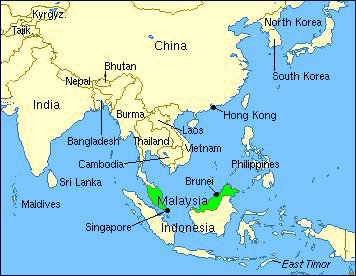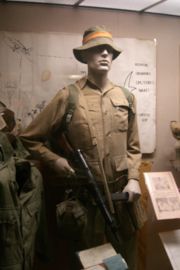Ilankai Tamil Sangam29th Year on the Web Association of Tamils of Sri Lanka in the USA |
|||||||||||||||
 Home Home Archives Archives |
The Malayan Emergencyby Wikipedia, accessed March 4, 2007
The Malayan Emergency was a state of emergency declared by the British colonial government of Malaya in 1948 and lifted in 1960, as well as an insurrection and guerrilla war fought between government forces and the Malayan National Liberation Army around the same period. The state of emergency entailed the revocation of many civil rights, the granting of special powers to the police, and other measures aimed at the suppression of left wing political movements, especially the Malayan Communist Party (MCP). The guerrilla war, which is also known as the Malayan War, was part of the ongoing conflict between the MCP and other leftists, and the colonial establishment, starting shortly after the Japanese withdrawal in 1945 and extending at least to the signing of the peace treaty between the communists and the government of Malaya in 1989. The Malayan National Liberation Army (MNLA) was the military arm of the MCP; it was formed shortly after the Emergency was declared in 1948.
Origins The withdrawal of Japan at the end of World War II left the Malayan economy disrupted; problems included unemployment, low wages, and scarce and expensive food. There was considerable labour unrest, and a large number of strikes occurred in 1946 through 1948. At the same time, the British administration was attempting to repair Malaya's war-damaged economy quickly, especially as income from Malaya's tin and rubber industries was important to Britain's own post-war recovery. As a result, strikers were dealt with harshly, by
The MNLA was partly a re-formation of the Malayan People's Anti-Japanese Army (MPAJA), the MCP-led guerrilla force which had been the principal resistance in Malaya against the Japanese occupation. The British had secretly trained and equipped the MPAJA during the later stages of World War II. The MPAJA was disbanded in December, 1945. Officially, it turned all of its weapons in to the British Military Administration at that time, however it is likely that some weapons were not returned and were stashed for possible future use.[citation needed] The anti-communists referred to the MNLA as "communist terrorists", which was often abbreviated to "terrs", "Charlie Tango" or "CTs". Guerrilla war "Malayan Emergency" was the colonial government's term for the war. The MNLA termed it "Anti-British National Liberation War".[1] Despite the usage of the term "emergency" it was in actuality a full-scale guerrilla war between the MNLA and British, Commonwealth, and Malayan armed forces; some have gone as far as to characterise it as a civil war.[citation needed] The rubber plantations and tin mining industries had pushed for the use of the term "emergency" since their losses would not have been covered by Lloyds insurers if it had been termed a "war". The MNLA commonly employed guerrilla tactics, sabotaging installations, attacking rubber plantations and destroying transportation and infrastructure.[2] Support for the MNLA was mainly based on around 500,000 ethnic Chinese then living in Malaya (there were 3.12 million Chinese in total); the ethnic Malay population supported them in smaller numbers. The MNLA raised the support of the Chinese because they were denied the equal right to vote in elections, had no land rights to speak of, and were usually very poor. The MNLA's supply organisation was called "Min Yuen." It had a network of contacts within the general population. Besides supplying material, such as food and weapons, it was also important to the MNLA as an information gatherer.
The MNLA had its hideouts in the rather inaccessible tropical jungle with limited infrastructure. Most MNLA guerrillas were ethnic Chinese, though there were some Malays, Indonesians and Indians among its members. The MNLA was organized into regiments. The regiments were considerably smaller than a regiment would usually be in a modern national army; the term was largely a geographical designation: each regiment operated in a different area of the country. The regiments had political sections, commissars, instructors and secret service. They also had lectures about Marxism-Leninism, and had political newsletters to be distributed to the locals. MNLA also stipulated that their soldiers had to get official permission for any romantic involvement with local women. In the early stages of the conflict, the guerrillas envisioned establishing "liberated areas" in which the government forces had been driven out and MNLA control established. They were unsuccessful, however, in establishing any such areas. The initial government strategy was primarily to guard important economic targets such as mines and plantation estates. Subsequently, Director of Operations Gen. Sir Harold Briggs developed an overall strategy known as the Briggs Plan. Its central tenet was that the best way to defeat an insurgency such as the government was facing is to cut the insurgents off from their supporters amongst the population. The Briggs Plan was multi-faceted; however one aspect of it has become particularly well known: this was the forced relocation of some 500,000 rural Malayans including 400,000 Chinese into guarded camps called "New Villages". These villages were newly constructed in most cases, and were surrounded by barbed wire, police posts, and floodlit areas, the purpose of which was both to keep the inhabitants in and the guerrillas out. People resented this at first but some soon became content with the better living standards in the villages. They were given money and ownership of the land they lived on. Removing a population which might be sympathetic to guerrillas was a counter-insurgency technique which the British had used before, notably against the Boer Commandos in the Second Boer War (1899–1902). In the international scene, the emerging Korean War eclipsed the developing conflict in Malaya. At the start of the Emergency, the British had a total of 13 infantry battalions, comprising seven partly-formed Gurkha battalions, three British battalions, two battalions of the Royal Malay Regiment and a British Royal Artillery Regiment being utilised as infantry.[3] This force was too small to effectively meet the threat of the "communist terrorists" or "bandits", and more infantry battalions were needed in Malaya. The British brought in soldiers from units like the Worcestershire Regiment, Royal Marines and King's African Rifles. Another effort was a re-formation of the Special Air Service as a specialised reconnaissance, raiding and counter-insurgency unit in 1950. The Permanent Secretary of Defence for Malaya, Sir Robert Thompson, had served in the Chindits in Burma during World War II, which meant that his vast experience in jungle warfare may have proved valuable during this period.[citation needed] In 1951, some British army units began a "hearts and minds campaign" by giving medical and food aid to Malays and indigenous Sakai tribes. At the same time, they put pressure on MNLA by patrolling the jungle. Units such as the SAS, the Royal Marines and Gurkha Brigade drove MNLA guerrillas deeper into the jungle and denied them resources. The MRLA had to extort food from the Sakai and earned their enmity. Many of the captured guerrillas changed sides. In comparison, the MRLA never released any Britons alive. In the end the conflict involved up to a maximum of 40,000 British and Commonwealth troops against a peak of about 7–8,000 communist guerrillas. Resolving the Emergency On October 7, 1951, the MNLA ambushed and killed the British High Commissioner, Sir Henry Gurney. The killing has been described as a major factor in causing the Malayan psyche to roundly reject the MRLA campaign, and also as leading to widespread fear due to the perception that "if even the High Commissioner was no longer safe, there was little hope of protection and safety for the man-in-the-street in Malaya."[4] More recently, MNLA leader Chin Peng has, by contrast, said that the killing had little effect, and that the communists anyway radically altered their strategy that month in their 'October Resolutions'.[citation needed] These responded to the Briggs Plan by reducing unit sizes, increasing jungle farming, and attempting to boost political work. Gurney's successor, Lieutenant General Gerald Templer was instructed by the British government to push for immediate measures to give ethnic Chinese residents the right to vote. He also pursued the Briggs's Plan, and sped up the formation of a Malayan army. At the same time he made it clear that the emergency itself was the main impediment to accelerating decolonisation. He also instituted financial rewards for detecting guerrillas by any civilians and expanded the intelligence network (Special Branch). Australia was willing to send troops to help a SEATO ally and the first Australian ground forces, the 2nd Battalion, Royal Australian Regiment (2RAR), arrived in 1955.[5] The battalion would later be replaced by 3RAR, which would in turn be replaced by 1RAR. The Royal Australian Air Force contributed No. 1 Squadron (Avro Lincoln bombers) and No. 38 Squadron (C-47 transports), operating out of Singapore, early in the conflict. In 1955, the RAAF constructed Butterworth air base, from which Canberra bombers of No. 2 Squadron (replacing No. 1 Squadron) and Sabres of No. 78 Wing carried out ground attack missions against the guerillas. The Royal Australian Navy destroyers Warramunga and Arunta joined the force in June 1955. Between 1956 and 1960, the aircraft carriers Melbourne and Sydney and destroyers Anzac, Quadrant, Queenborough, Quiberon, Quickmatch, Tobruk, Vampire, Vendetta and Voyager were attached to the Commonwealth Strategic Reserve forces for 6-9 months at a time. Several of the destroyers fired on Communist positions in Johor State. Realising that his conflict has not come to any fruition, Chin Peng sought a referendum with the ruling British government alongside many Malayan officials at Baling in 1955. The meeting was intended to pursue a mutual end to the conflict but the Malayan government representatives, led by Tunku Abdul Rahman, dismissed all of Chin Peng's demands. As a result, the conflict heightened and, in response, New Zealand sent NZSAS soldiers, No. 14 Squadron RNZAF and later No. 75 Squadron RNZAF, and other Commonwealth members also sent troops to aid the British. With the independence of Malaya under Prime Minister Tunku Abdul Rahman on August 31, 1957, the insurrection lost its rationale as a war of colonial liberation. The last serious resistance from MRLA guerrillas ended with a surrender in the Telok Anson marsh area in 1958. The remaining MRLA forces fled to the Thai border and further east. On July 31, 1960, the Malayan government declared the Emergency was over, and Chin Peng left south Thailand for Beijing where he was accommodated by the Chinese authorities in the International Liaison Bureau, where many other Southeast Asian Communist Party leaders were housed. During the conflict security forces killed 6,710 MRLA guerrillas and captured 1,287. Of the total number of guerrillas, 2,702 surrendered during the conflict and about 500 at the end of the conflict. There were 1,346 Malayan troops and 519 British military personnel killed. 2,478 civilians were killed and 810 recorded missing as a result of the conflict. Comparisons The conflicts in Malaya and Vietnam have been compared many times and it has been asked by historians as to how a British force of 35,000 succeeded where over a half million U.S. and others soldiers failed. However the two conflicts differ in several key points.
Legacy In the late 1960s the coverage of the My Lai massacre during the Vietnam War prompted the initiation of investigations in the UK concerning alleged war crimes perpetrated by British forces during the Emergency. One of such allegations is the Batang Kali massacre. No charges arose however, and it has been suggested that the incoming government of Edward Heath acted improperly in terminating the investigations.[citation needed] In popular Malaysian culture, the Emergency has sometimes been portrayed as a primarily Malay struggle against the communists. However, this perception has been criticised by several, such as Information Minister Zainuddin Maidin, for not recognising Chinese and Indian efforts.[8] In literature
| ||||||||||||||
 measures including arrests and deportations. The strikers became increasingly militant, and violent incidents occurred. When, on
measures including arrests and deportations. The strikers became increasingly militant, and violent incidents occurred. When, on 